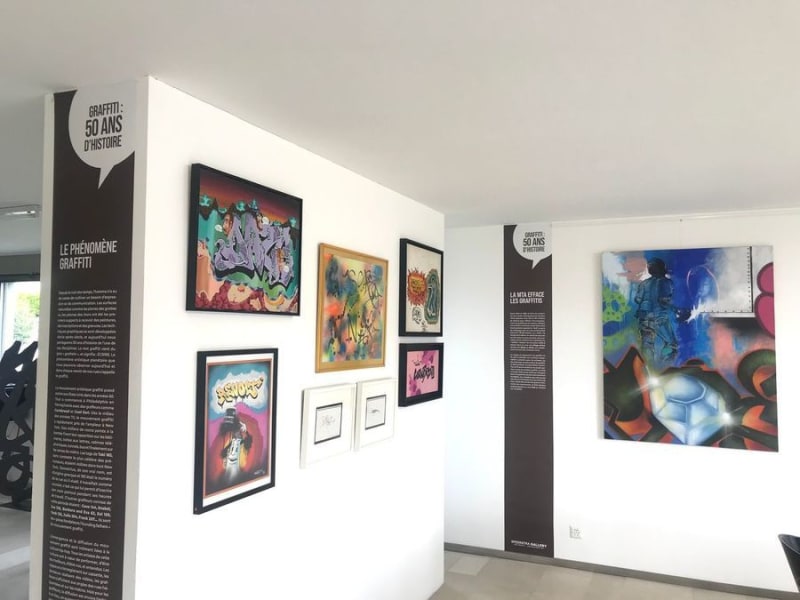Dondi White, MinOne, Daze, JonOne, Crash, Revolt, Rammellzee, Futura, Noc 167, Henry Chalfant, Stohead, Sozyone, Alëxone, Mambo, Tilt et Fafi, Mist, Remi Rough, Lazer 3.14, L’Atlas, Smash137, Jazi, Serval, Rosyone, Thierry Furger, Xavier Magaldi, Sigi Dare von Koeding and Swox.
Since the dawn of time, mankind has never ceased to cultivate a need for expression and communication. Natural surfaces, such as the stones of caves or walls, were the first supports to receive paintings, inscriptions and engravings. Graphic techniques have developed century after century, and today we share fifty years of history of one of these disciplines.
It all started in the late 60's in Philadelphia, Pennsylvania with graffiti artists like Cornbread and Cool Earl. By the mid-70's, the graffiti movement was quickly gaining momentum in New York City. Thousands of spray-painted names appeared on buildings, mailboxes, phone booths, tunnels, buses and eventually on subway cars. The tags of Taki 183, arguably the most famous of the precursors, were visible all over New York. Demetrius, his real name, is of Greek origin and 183 was the number of the street where he lived. He worked as a courier, which allowed him to put his name everywhere during his working hours. Other famous graffiti artists of this period were: Coco144, Snake1, Joe 136, Barbara and Eva 62, Eel 159, Yank 135, Julio 204, Frank 207, etc. They are the founding fathers of the graffiti movement. The emergence and the diffusion of the graffiti movement are intimately linked to the hip-hop culture. All the artists of this culture have at heart to perform, to be the best, to be seen and heard. Coming from the underprivileged social strata for the vast majority of them, their art is also a social manifesto. The rappers record themselves on tape, the dancers make videos, the graffiti artists post themselves on the corners of busy streets and on the subways. But for the graffiti artists, the diffusion is still limited to a place, a fixed support. The works can not cross the Atlantic or be in a private home, until the year 1972.
At that time, Hugo Martinez, a sociologist at New York University, immediately identified the artistic potential of this first generation of artists. The UGA crew (United Graffiti Artists) and Hugo Martinez selected the most fashionable graffiti artists of the time and organized the very first graffiti exhibition at the Razor Gallery. UGA was provided with opportunities that were then unavailable to these artists; the artists represented were: Phase 2, Mico, Coco144, Pistol, Flint707, Bama, Snake1 and Stitch1.
The exhibition begins with a historic work that marks the beginning of the international diffusion of the movement. The work "King of all kings" by artist Snake1 is one of the first works made on canvas. This work inscribes the movement in the history of art, using the same medium as the great masters of classical painting. From then on, graffiti could travel, be exhibited and collected. It is this passage from the street to the canvas that we will later name post-graffiti.
"Graffiti: 50 years of history", traces the course of a singular movement. The selection of works provides an overview of the artists who have contributed to this history. The American precursors begin the exhibition, with historical works, archival photos and sketches. Works by Dondi White, MinOne, Daze, JonOne, Crash, Revolt, Rammellzee, Futura, Noc 167, Henry Chalfant, etc.
The European production, more recent, shows the graphic evolution of the discipline. We find works by Stohead, Sozyone, Alëxone, Mambo, Tilt and Fafi, Mist, Remi Rough, Lazer 3.14, L'Atlas, etc.
The exhibition dedicates the Switzerland scene with works by artists who are now internationally renowned. Smash137, Jazi, Serval, Rosyone, Thierry Furger, Xavier Magaldi, Sigi Dare von Koeding and Swox.
© Speerstra Gallery










